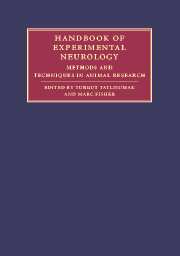Book contents
- Frontmatter
- Contents
- List of contributors
- Part I Principles and general methods
- 1 Introduction: Animal modeling – a precious tool for developing remedies to neurological diseases
- 2 Ethical issues, welfare laws, and regulations
- 3 Housing, feeding, and maintenance of rodents
- 4 Identification of individual animals
- 5 Analgesia, anesthesia, and postoperative care in laboratory animals
- 6 Euthanasia in small animals
- 7 Various surgical procedures in rodents
- 8 Genetically engineered animals
- 9 Imaging in experimental neurology
- 10 Safety in animal facilities
- 11 Behavioral testing in small-animal models: ischemic stroke
- 12 Methods for analyzing brain tissue
- 13 Targeting molecular constructs of cellular function and injury through in vitro and in vivo experimental models
- 14 Neuroimmunology and immune-related neuropathologies
- 15 Animal models of sex differences in non-reproductive brain functions
- 16 The ependymal route for central nervous system gene therapy
- 17 Neural transplantation
- Part II Experimental models of major neurological diseases
- Index
- References
5 - Analgesia, anesthesia, and postoperative care in laboratory animals
Published online by Cambridge University Press: 04 November 2009
- Frontmatter
- Contents
- List of contributors
- Part I Principles and general methods
- 1 Introduction: Animal modeling – a precious tool for developing remedies to neurological diseases
- 2 Ethical issues, welfare laws, and regulations
- 3 Housing, feeding, and maintenance of rodents
- 4 Identification of individual animals
- 5 Analgesia, anesthesia, and postoperative care in laboratory animals
- 6 Euthanasia in small animals
- 7 Various surgical procedures in rodents
- 8 Genetically engineered animals
- 9 Imaging in experimental neurology
- 10 Safety in animal facilities
- 11 Behavioral testing in small-animal models: ischemic stroke
- 12 Methods for analyzing brain tissue
- 13 Targeting molecular constructs of cellular function and injury through in vitro and in vivo experimental models
- 14 Neuroimmunology and immune-related neuropathologies
- 15 Animal models of sex differences in non-reproductive brain functions
- 16 The ependymal route for central nervous system gene therapy
- 17 Neural transplantation
- Part II Experimental models of major neurological diseases
- Index
- References
Summary
Overview
Anesthesia in experimental animals is essential for both humane and scientific reasons to reduce or eliminate the pain and anxiety derived from physiological examinations or surgical treatments. Anesthesia also helps to immobilize animals to minimize the risk of injurious animal movements that could affect the outcome of experiments. Use of anesthesia should always be considered whenever experimental procedure accompanies the risk for animals to be caused pain or stress. Anesthetic agent is delivered either by injection or inhalation. Of those that are given by injection, the action may be local or systemic.
For clarity, the following terms are defined:
Sedation/tranquilization is a state of mild central depression in which the animal is awake and calm.
Analgesia refers to a temporal reduction of pain sensation accompanied by a trance-like neurolepsis, which is a state of depressed awareness of the surroundings.
Anesthesia is defined as a temporal and reversible reduction or elimination of feeling or sensation, often accompanied by loss of consciousness. When anesthesia is required, the purpose and extent of experimental procedure to be performed should be evaluated in order to determine if analgesia, sedation, or surgical anesthesia would be appropriate for a given procedure.
Many of the drugs used for anesthesia, such as opioids and barbiturates, are controlled and regulated by law. Information on controlled drug registration and also institutional/university policy should be obtained before starting to experiment. Licenses are needed to purchase these agents, and written records on purchase, storage, use, and disposal of them must be kept in a file.
- Type
- Chapter
- Information
- Handbook of Experimental NeurologyMethods and Techniques in Animal Research, pp. 40 - 66Publisher: Cambridge University PressPrint publication year: 2006



